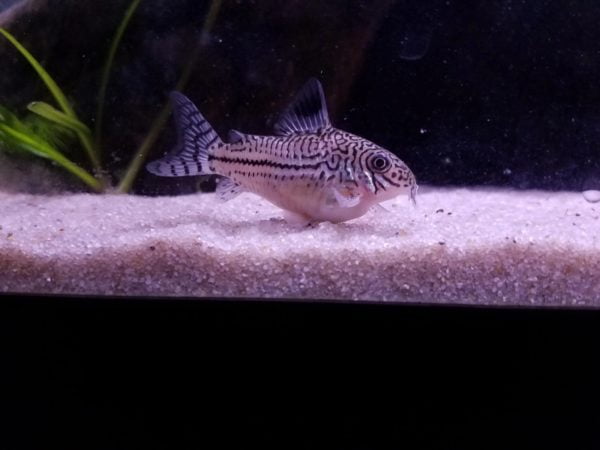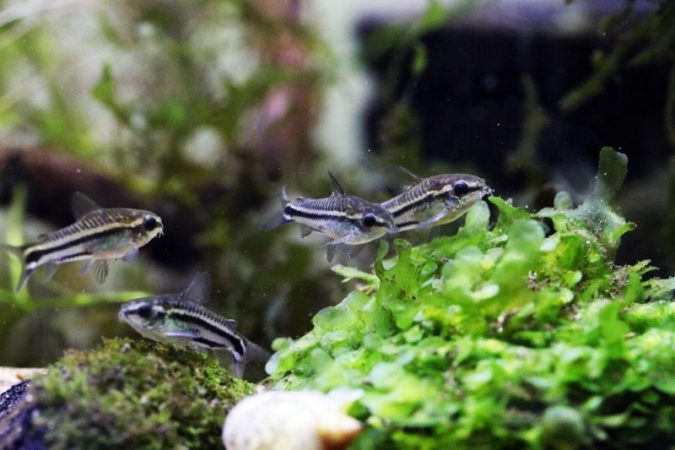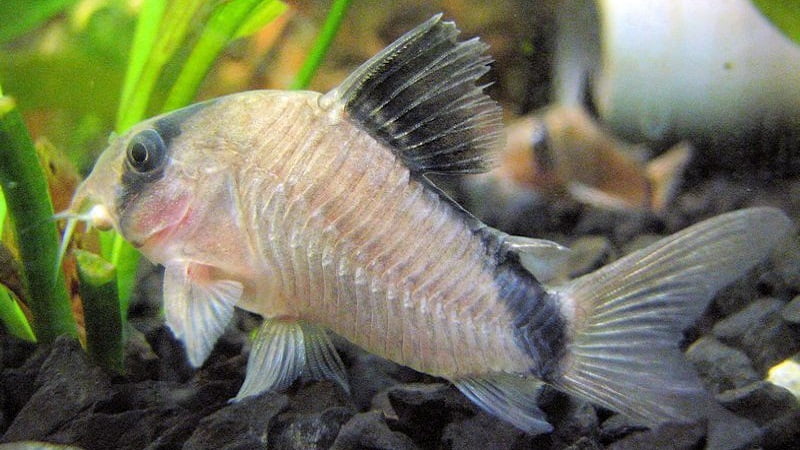When water or other fluids accumulate in your cory catfish’s body cavity, such as in the abdomen, it results in a swollen condition called dropsy. There are several causes of cory catfish dropsy, but this condition is often the result of infections.
Treating dropsy is extremely challenging. However, it is possible for your corydoras to get cured and fully recover from dropsy if this condition is diagnosed early, especially when the affected fish can be isolated.
In this article, I will provide you with all essential and imperative information about the cory catfish dropsy, including causes, symptoms, treatments, and the best ways to prevent this condition on your fish.
Causes Of Cory Catfish Dropsy
Dropsy is usually caused by the very common Aeromonas bacteria, one of several Gram-negative bacteria commonly found in aquariums. This bacteria is generally related to two major diseases: gastroenteritis and wound infections, both of which often occur easily in contaminated water environments.
Thus, the cory catfish with degraded immune systems and untreated wounds could get the severe infection from Aeromonas bacteria. The weakened immune systems in your cory catfish can be caused by physical trauma and other environmental stressors, including:
- Poor water quality: this is a significant factor that leads to the reduced resistance against bacteria in your cory catfish. This problem is also associated with high levels of ammonia and nitrite.
- A large and sudden drop or increase in water temperature: it will be hard for your fish to adapt to this sudden and significant change in water temperature. It will also result in a hazardous shock to your fish.
- Stress from transportation: Inappropriate transporting methods could also make your fish stressed.
- Inappropriate food, overfeeding, or lack of nutrients: A nutritious diet is one of the important criteria to keep your cory catfish healthy. They are susceptible to infections if they can not get enough food or are overfed.
- Unsuitable tankmates: Aggressive fish are bad tank mates for your peaceful cory catfish. Your fish will be inactive, stressed, and lethargic.
- Other diseases and infections: Your cory catfish can get sick from their tank mates since most aquarium diseases are contagious.
Dropsy Symptoms In Cory Catfish
The underlying bacterial infections can cause a wide range of symptoms of cory catfish dropsy. Dropsy and swim bladder disorders can also be confused upon diagnosis as both shows similar symptoms, such as distended bellies, curled spines, and general malaise. The classic symptom of dropsy is a swollen belly. Other fish may show skin lesions or even show no signs of the disease at all.
As a result, dropsy is difficult to diagnose. Physical as well as behavioral symptoms can be observed in many cases. However, your veterinarian will probably need to do lab tests to figure out the type of infection in your cory catfish so that they can determine an appropriate antibiotic for treatment.
So, if you suppose that your cory catfish get dropsy by infection, you should take them to the local veterinarian for the best consult and treatment.
Here are some dropsy-related symptoms you can observe on your cory catfish:
- Grossly swollen belly: When your cory catfish get dropsy, they will look like a balloon about to explode. It is easily mistaken that they are getting fat. This condition is caused by the fluid accumulation in the abdomen’ soft tissues and cavities to create swelling. Their kidneys and spleen are also swollen since they do not function properly and can’t get rid of the water built up within their body.
- Bulging eyes: Often, small fish with severe infections or who suffer from dropsy may also have bulging eyes due to excessive fluid pressure.
- Pale gills: Infections or diseases that result in dropsy can also cause anemia in your fish, leading to the loss of coloration on their gills.
- Swollen or red anus: Your fish will have a swollen and red anus, as well as other parts of its body, if it has the bacterial “enteric redmouth disease.”, which usually accompanies other signs of dropsy condition.
- Pale or stringy feces: Your fish may not eat if it has an infection or other symptoms of dropsy. When your cory fish are infected and/or have dropsy, they probably refuse to eat, leading to pale feces. You will also find that sick fish secrete much more mucus than actual feces, meaning that what they release will be pale and stringy.
- Ulcers: Fish suffering from dropsy may have ulcerated skin caused by a severe bacterial infection. Ulcers are usually found along their body’s side.
- Curved spine: If your fish has dropsy, their spine may appear curved as their abdomen is filled with fluid, and their organs are pushed aside.
- Clamped fins: When a fish is sick, its fins are held abnormally tightly to its body (clamped fins). If its body is swollen, distended, and in pain, it may clamp its fins to prevent them from moving.
- Red skin or red fins: If your fish has an Aeromonas infection, which triggers dropsy symptoms, they will hemorrhage on or under the skin and appear to have bloody red skin and red fins.
- Lethargy: A disease plus other symptoms of dropsy will certainly exhaust your cory catfish. Generally, their organs and bodies do not function properly, making them lethargic.
- Not interested in eating: When your fish have dropsy, they will cease eating owing to discomfort and dysfunctional organs. If your fish is not feeling well or is not interested in food, you may see them hiding in aquatic plants most of the time.
- Swimming near the water surface: As it is difficult for fish with dropsy to maintain their natural buoyancy and swim properly, you may find that they will reside near the surface water surface of the tank.

Treatment For Cory Catfish Dropsy
Infected fish can be saved if they are isolated for proper treatment and detected early. The goal of treatment is to correct the underlying problem while also providing supportive care to the sick fish. Here are some essential actions you need to take to treat your cory catfish dropsy:
Quarantine: Separate your infected cory catfish in a “hospital tank.” It is important to separate all infected fish from the remaining healthy fish to avoid spreading infection over your aquarium.
Add salt: Dissolve one teaspoon of salt per gallon of water in the hospital tank. A low salinity level in the water allows fish to maintain their osmotic balance since the water salinity is similar to that in their blood. This allows the fish to expel the accumulated water, causing dropsy, in their bodies. However, do not add too much salt, as freshwater fish can become ill from a too high salt level in their water.
Clean water: Perform a weekly partial water change in the hospital tank, adding salt to the new water as it enters. A regular water-parameter check is needed to make sure the water in the hospital tank is suitable for the fish on a daily basis.
Provide food: Provide the sick fish with a wide variety of fresh, high-quality foods. In cases where the infection has not progressed too far as long as the fish is still eating, this is often an adequate treatment method.
Using antibiotics: The fish should be treated with antibiotics, either in the food or in the water, if they do not respond well to the water and food improvements. It is recommended to take a broad-spectrum antibiotic formulated for Gram-negative bacteria, such as Maracyn-Two. It is ideal to use 10 days of antibiotics to ensure the infection is eliminated, but always follow the directions on the package for duration and dosage.
Observation: The cory fish should be observed for several weeks after the dropsy symptoms have disappeared.
Maintain the main tank: Change the water in the original tank while the affected fish are quarantined, and also observe the remaining fish in the main tank to spot any symptoms timely, if any.
Prognosis For Cory Catfish With Dropsy
Usually, it is not easy to cure the disease or infection that causes dropsy. Some experts recommend euthanizing all of the infected fish for the sake of preventing the spread of the infection to healthy fish. Fish suffering from both popeye and dropsy usually face a particularly harsh outcome.
Despite prompt treatment, your dropsy-infected fish is at high risk of death, but there are also high chances of survival. Fish that are diagnosed in the early stages of the infection have a higher chance of successful treatment.
How To Prevent Cory Catfish Dropsy
As I have mentioned, environmental stressors are critical causes weakening your cory catfish’s immune system, making them more vulnerable to disease and infections, including dropsy.
In general, the ability to fight infection of your cory catfish will not be compromised by a single or short-term exposure to stress. Usually, their immunity is affected by stress exposure occurring over an extended period of time or by multiple stress factors concurrently occurring.
Thus, the best prevention for cory catfish dropsy is to limit the stressors affecting them. This could be successfully minimized by enhancing their living quality.
Stress is often caused by poor water quality; therefore, tank maintenance is imperative. Consider the following factors when maintaining your tank:
- Make sure the aquarium water is healthy for your fish by testing it regularly.
- Change the water at regular intervals.
- Maintain a clean aquarium.
- Regularly clean the filter.
- Using a gravel vacuum to remove waste from the bottom of the tank.
- Make sure the tank is not overcrowded.
- Avoid overfeeding your fish.
- Use flake foods within 1 month of opening.
- Mix up the diet of your cory catfish to ensure they have enough nutrient
- Select suitable tank mates and house your cory catfish in groups to stimulate their activity level.
In short, infections causing dropsy can be prevented if your fish are fed a healthy diet, and the tank is maintained well.

FAQs
Is dropsy contagious to other fish?
Any fish exposed to dropsy-causing bacteria can exhibit dropsy symptoms since the bacteria are present in all aquariums. However, healthy fish are rarely affected by dropsy.
This only happens when the fish’s immune system has been compromised by some other stress factor. It is quite common to find an entire tank infected when all the fish are stressed, but it is also possible for just one or two fish to be affected, especially when prompt action is taken to prevent the spread of bacteria.
Is it Dropsy or Swim Bladder Disorder?
Aquatic fish diseases such as dropsy and swim bladder disease are often confused. The reason is that they both present the same alarming symptom: a bloated fish with a dangerously large belly.
The dropsy condition is caused by excessive internal fluid pressure stretching the soft tissues. In contrast, swim bladder disorder is caused by internal gasses within the organ.
Like dropsy, swim bladder disorder can result from a bacterial infection inside the body. However, it can also be caused by injury or a sudden imbalance in the gas concentration in your fish.
Swim bladder disorder is not only characterized by bloating but also by the difficulty in swimming and maintaining buoyancy. Fish with a swim bladder disorder usually bob and float spontaneously, making it even harder to swim naturally. In contrast to dropsy disease, the bloating in swim bladder disorder is less severe.
Moreover, their scales will never stand straight if your fish have a swim bladder disorder. This, however, is a symptom associated with dropsy. Thus, you can tell the difference between dropsy and swim bladder disease by looking at their scales.
Conclusion
Dropsy is typically called edema or ascites; it refers to an incredibly swollen belly in fish.
There are several factors causing cory catfish dropsy condition, but the leading cause is bacteria infection. The root of such infections is the weakened immune system, often initiated by poor water quality.
The best way to prevent dropsy in your cory catfish is to ensure good water quality and provide your fish with a healthy and nutritious diet to minimize the stressors and increase their immunity.

Annette M. Chaney is an experienced marine biologist with over 20 years of experience as an aquarist and fishkeeper. She started her first aquarium at a young age, filling it with frogs and goldfish obtained from the ten-cent pet store.
Annette grew up caring for and breeding African Cichlids, which led to a hobby in high school that doubled as a profitable means. Attending Reed College gave her time to solidify herself as an accomplished aquarium caretaker with an eye for sales. After that, from 2009 – 2013, she studied at Roger Williams University – one of the most prestigious universities for Aquaculture and Aquarium in USA. She is the founder of AquariumCircle since 2010.
